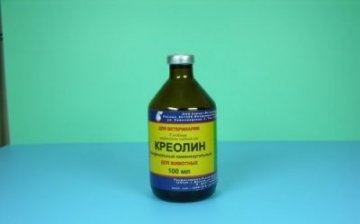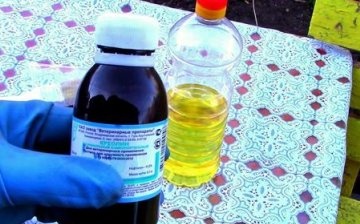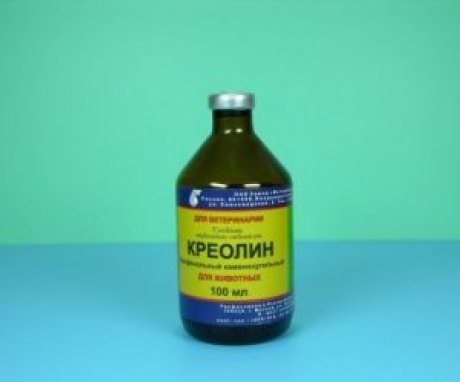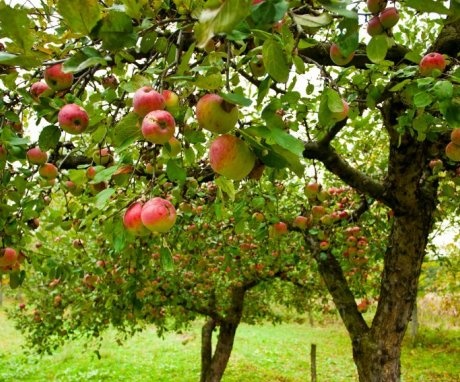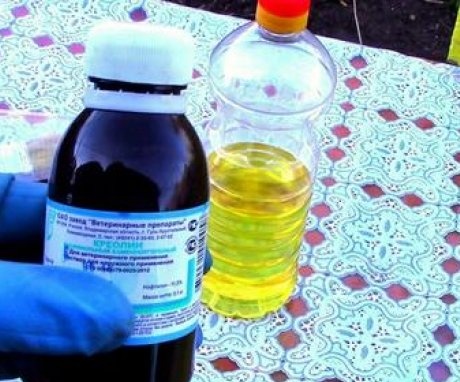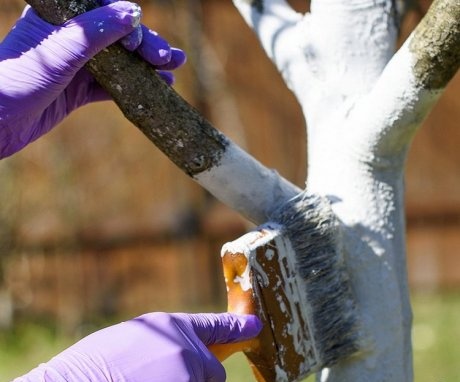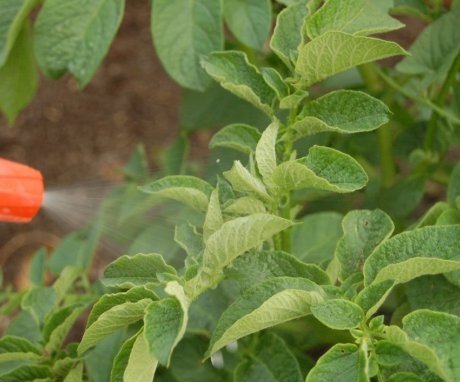Creolin in horticulture: methods and rules of application
To keep the fruit trees of the garden healthy, to save them from pests, repellants with a pungent smell are used. These properties are possessed by creolin, a drug that is well known to veterinarians. Although the remedy has been known for a long time, gardeners and gardeners rarely use it, not knowing about its benefits for plants.
Content:
- Creolin - what is it?
- When and why is the drug used in gardening?
- Rules for the use of creolin
- Creolin for whitewashing trees
- Using creolin in the garden
Creolin - what is it?
Products of oil refining and coal have strong odors and viscosity. Their useful actions include the ability to disinfect. No wonder they are used to impregnate wooden sleepers, telegraph poles. Many have found their application in veterinary medicine and horticulture.
A viscous liquid with a pronounced pungent odor consists of naphthalene, coal oil, ichthyol.
This is creolin, which has a disinfectant effect. The main role in the antiseptic, antiparasitic properties of the drug is played by coal oil, which is obtained from resins. It is from this substance that various varnishes, disinfectants used in agriculture are prepared. It is not for nothing that coal oils are called standards of antiseptics.
If earlier creolin was widely used in medicine for disinfecting wounds, now it is treated with plants to save from pests, pet hair from parasites.
You need to know that in its pure form, creolin is toxic, therefore, it is used in solution for processing plants.
When and why is the drug used in gardening?
Experienced gardeners have known a remedy with the smell of creazote for a long time. Creolin helps preserve fruit tree seedlings after frostbite. Heal any wounds on the trunks and branches of trees and shrubs under the power of an antiseptic. Saplings, after being lubricated with a creolin emulsion, are well preserved and recover after a difficult period of winter.
For the garden, the real enemies and destroyers are mice. They gnaw the bark, and in the spring the tree dies. Hares also like to feast on the bark of fruit trees and bushes. Creolin will save young plants, the active substances of which revive the damaged parts of the branches and trunk, and scare off rodents.
Creolin is used against garden pests both in early spring and late autumn.
The smell of the drug will not only scare away insects, rodents, but also protect against diseases caused by pathogenic microorganisms. Plants smeared with creolin will be freed from leaf-gnawing caterpillars, aphids, ants. Not only the trees and shrubs of the garden are treated with creolin, but also the ground, since the larvae of parasites like to winter in it. Affordable and easy to use, Creolin will help preserve and rejuvenate your garden's fruit trees and yield fruit yields.
Rules for the use of creolin
There are certain rules for using creolin in horticulture. They must be adhered to, since the product is highly toxic:
- For the treatment of frostbitten parts of the trunk and branches of trees, take an emulsion of creolin, diluting one teaspoon of a viscous substance in a glass of warm water.A soft cloth is moistened abundantly with the agent and the damaged parts of the tree, cracks, and places of breakage are lubricated with an emulsion. It is best to wrap the rag around a stick to avoid staining or scalding your hands. The operation is performed with rubber gloves.
- In the fall, take one teaspoon of creolin and mix it with one liter of sunflower oil. The resulting solution is lubricated with the lower part of the barrel and wrapped in a cloth. The creolin-impregnated trunk is not touched by either mice or hares.
- If in the spring it was found that part of the bark was eaten, then it is also lubricated with an emulsion of creolin in water, and after the start of sap flow - in vegetable oil.
- In the summer, a solution of the agent is used, lubricating the places of accumulation of caterpillars, aphids. You can mix one or two tablespoons of the drug with half a liter of celandine broth. It remains to spray trees and bushes infected with aphids.
- Ants often take a liking to places in the garden next to fruit trees, causing damage to plantings. You can protect yourself from them by moistening the ground around the trees with a creolin emulsion. The procedure is carried out both in summer and autumn. Insects will stop nesting in the bark of fruit trees if you encircle the trunk with a plant-based solution of creolin.
Creolin in horticulture is an indispensable tool for helping to preserve horticultural crops.
Creolin for whitewashing trees
Whitewashing the trunks of trees and shrubs is important in preparing the garden for winter. So you can make plants resistant to winter damage by rodents, protect them from snow storms, sunburn.
The procedure is carried out when the air temperature drops to 0 degrees. This usually happens in October. But if frosts hit, then you can whitewash the trunks during the thaw. It is important for the procedure that the weather is dry, without precipitation. Creolin is added to the whitewashing solution, which scares off mice and hares with its characteristic odor, destroys the larvae of aphids and spider mites hidden under the bark.
Whitewashing is an effective procedure in protecting the garden from pests and diseases.
To prepare the whitewash mixture, take one liter of water and add one hundred grams of copper sulfate to it. To keep the solution better on the trunk, add five hundred grams of PVA glue. Creolin is needed in an amount of ten grams. When all the components are thoroughly mixed, it remains to fill in five hundred grams of chalk or lime. Whitewashing is carried out when the mixture is infused for several hours. There should be no lumps in it.
The procedure begins with stripping the bark, covering garden pitch all cracks and damage. Whitewashing is carried out from the bottom of the trunk, gradually rising up. Skeletal branches are also coated with a solution to the place of the fork. After the procedure, the earth is cleared of bark particles. And so that the solution does not get into the ground, non-woven material is spread around the trees in advance.
Using creolin in the garden
To preserve the harvest of vegetables, to save plants from pests, creolin is also used. In the fall, after collecting root crops, the soil is treated with a creolin emulsion. The drug helps to perish the larvae of pests hiding in the ground for the winter. Vegetable beds will not be attacked caterpillarsif you put creolin-soaked sawdust on the paths.
At the beginning of the egg-laying period, cabbage pests - flies, onion hoverflies are sprinkled with wood ash moistened with creolin. You can soak the soil or sand on the paths with a fragrant agent.
The role of creolin in the fight against pests in the garden is high; it is effective against aphids, caterpillars, earthen fleas.
Mostly creolin is used in the garden as a deterrent:
- Will protect cabbage from the attack of bedbugs, a mixture of fluff lime and creolin, which is prepared in a ratio of 20: 1. If you place traps next to cabbage beds, where a cloth soaked in creolin is placed, then scoop butterflies will bypass the area with the vegetable.
- On the basis of creolin, the drug Creocid has been created, which is used to spray potatoes during the growing season, dissolving four milliliters of the product in ten liters of water. It is effective against the Colorado potato beetle. Scare away the pest and jars of creolin, hung on the bushes potatoes.
- From the onion fly, the plants are sprayed with a solution, taking a teaspoon of the aromatic substance in three liters of water.
Creolin is a long-forgotten remedy that will help eliminate pests from the beds.
More information can be found in the video:




